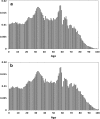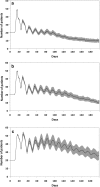Effectiveness assessment of countermeasures against bioterrorist smallpox attacks in Japan using an individual-based model
- PMID: 19784718
- PMCID: PMC2824104
- DOI: 10.1007/s12199-009-0111-z
Effectiveness assessment of countermeasures against bioterrorist smallpox attacks in Japan using an individual-based model
Abstract
Objectives: This study is aimed at the evaluation of countermeasures in terms of the total number of patients and deaths, the number of vaccine doses used, and the time for eradication as examined through simulations of the outbreak of smallpox following a bioterrorist attack in the center of Okayama City. Three countermeasures were considered: traced vaccination (TV), mass vaccination (MV), and school closure.
Methods: An individual-based model was adopted, in which every individual is assigned their own personal information, behavioral pattern, and interactions among social settings to simulate the situation on a realistic basis. The influence of residual immunity obtained by past vaccination reflected age-dependent immunity to smallpox in Japan.
Results: MV performed within a 2-day period at the same time in 10 school districts had the highest effectiveness in reducing the total number of patients and deaths among all simulations. Performing both TV and MV simultaneously was much more effective than performing TV or MV individually. The decrease in the number of patients with TV or MV in combination with school closure was faster than that by TV or MV without school closure.
Conclusions: According to the simulations results, it was advisable to carry out MV, or both TV and MV, simultaneously with school closure as countermeasures against a smallpox epidemic initiated by a bioterrorist attack.
Figures










Similar articles
-
Estimation of the duration of vaccine-induced residual protection against severe and fatal smallpox based on secondary vaccination failure.Infection. 2006 Oct;34(5):241-6. doi: 10.1007/s15010-006-6603-5. Infection. 2006. PMID: 17033746
-
Containing a large bioterrorist smallpox attack: a computer simulation approach.Int J Infect Dis. 2007 Mar;11(2):98-108. doi: 10.1016/j.ijid.2006.03.002. Epub 2006 Aug 8. Int J Infect Dis. 2007. PMID: 16899385
-
Effects of behavioral changes in a smallpox attack model.Math Biosci. 2005 Jun;195(2):228-51. doi: 10.1016/j.mbs.2005.03.006. Math Biosci. 2005. PMID: 15913667
-
Smallpox vaccination and bioterrorism with pox viruses.Comp Immunol Microbiol Infect Dis. 2003 Oct;26(5-6):423-30. doi: 10.1016/S0147-9571(03)00025-0. Comp Immunol Microbiol Infect Dis. 2003. PMID: 12818626 Review.
-
The smallpox vaccine: An update for oral health care professionals.J Am Dent Assoc. 2006 Apr;137(4):452-60. doi: 10.14219/jada.archive.2006.0216. J Am Dent Assoc. 2006. PMID: 16637473 Review.
Cited by
-
Mathematical models and analysis tools for risk assessment of unnatural epidemics: a scoping review.Front Public Health. 2024 May 2;12:1381328. doi: 10.3389/fpubh.2024.1381328. eCollection 2024. Front Public Health. 2024. PMID: 38799686 Free PMC article.
-
Modelling of optimal vaccination strategies in response to a bioterrorism associated smallpox outbreak.Hum Vaccin Immunother. 2021 Mar 4;17(3):738-746. doi: 10.1080/21645515.2020.1800324. Epub 2020 Dec 2. Hum Vaccin Immunother. 2021. PMID: 33734944 Free PMC article.
-
Systematic review of strategies to manage and allocate scarce resources during mass casualty events.Ann Emerg Med. 2013 Jun;61(6):677-689.e101. doi: 10.1016/j.annemergmed.2013.02.005. Epub 2013 Mar 20. Ann Emerg Med. 2013. PMID: 23522610 Free PMC article.
References
-
- National Institute of Infectious Diseases. Infect Dis Wkly Rep Jpn. 2001; 40:8–10 (in Japanese).
-
- Ministry of Health, Labour and Welfare, Japan. The policy against smallpox (The fifth edition). Tokyo; 2004. (in Japanese).
-
- Fenner F, Henderson DA, Arita I, Jezek Z, Ladnyi ID. Smallpox and its eradication. Geneve: WHO; 1988.
LinkOut - more resources
Full Text Sources
Miscellaneous
